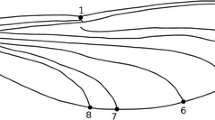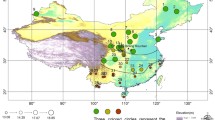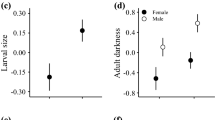Abstract
Wing-dimorphic, delphacid planthoppers were used to test hypotheses concerning the effects of habitat persistence and architectural complexity on the occurrence of dispersal. For reasons concerning both the durational stability of the habitat and the reduced availability of mates, selection has favored high levels of dispersal in species occupying temporary habitats. Flightlessness predominates in species occupying persistent habitats, and is promoted by a phenotypic trade-off between reproductive success and flight capability. Wings are retained in tree-inhabiting species, probably for reasons concerning the more effective negotiation of three-dimensional habitats. In contrast, flightlessness is characteristic of those species inhabiting low profile host plants. For several delphacid genera, migratory species are larger than their sedentary congeners. Because body size and fecundity are positively related in planthoppers, the large body size observed in migratory taxa may result from selection for increased fecundity in colonizing species.
Similar content being viewed by others
References
Barbosa, P., V. Krischik and D. Lance (1989) Life-history traits of forestinhabiting flightless Lepidoptera.Am. Midl. Nat. 122: 262–274.
Brown, V. K. (1982) Size and shape as ecological discriminants in successional communities of Heteroptera.Biol. J. Linn. Soc. 18: 279–290.
Bull, J. J., C. Thompson, D. Ng and R. Moore (1987) A model for natural selection of genetic migration.Am. Nat. 129: 143–157.
Cheng, J., Holt, J. and G. A. Norton (1994) A systems approach to planthopper population dynamics and its contribution to the definition of pest management options. pp. 635–655.In R. F. Denno and T. J. Perfect (eds.)Planthoppers: their ecology and management. Chapman & Hall, New York.
Claridge, M. (1985) Acoustic signals in the Homoptera: behavior, taxonomy, and evolution.Annu. Rev. Entomol. 30: 297–317.
Cook, A. and T. J. Perfect (1985) The influence of immigration on population development ofNilaparbata lugens andSogatella furcifera and its interaction with immigration by predators.Crop Protection 4: 423–433.
Coyne, J. A. and B. Milstead (1987) Long-distance migration ofDrosophila. 3. Dispersal ofD. melanogaster alleles from a Maryland orchard.Am. Nat. 130: 70–82.
den Boer, P. J. (1981) On the survival of populations in a heterogeneous and variable environment.Oecologia 50: 39–53.
den Boer, P. J., H. P. T. van Huizen, W. den-Boer Daanje, B. Aukema and C. F. M. den Bieman (1980) Wing polymorphism and dimorphism in ground beetles as stages in an evolutionary process (Coleoptera: Carabidae).Entomol. Generalis 6: 107–134.
Denno, R. F. (1978) The optimum population strategy for planthoppers (Homoptera: Delphacidae) in stable marsh habitats.Can. Entomol. 110: 135–142.
Denno, R. F. (1983) Tracking variable host plants in space and time. pp. 291–341.In R. F. Denno and M. S. McClure (eds.)Variable plants and herbivores in natural and managed systems. Academic Press, New York.
Denno, R. F. (1994) Life history variation in planthoppers. pp. 163–215.In R. F. Denno and T. J. Perfect (eds.)Planthoppers: their ecology and management. (Chapman & Hall, New York.
Denno, R. F. and H. Dingle (1981) Consideration for the development of a more general life history theory. pp. 1–6.In R. F. Denno and H. Dingle (eds.)Insect life history patterns: habitat and geographic variation. Springer, New York.
Denno, R. F., L. W. Douglass and D. Jacobs (1985) Crowding and host plant nutrition: environmental determinants of wing-form inProkelisia marginata.Ecology 66: 1588–1596.
Denno, R. F. and E. E. Grissell (1979) The adaptiveness of wingdimorphism in the salt marsh-inhabiting planthopper,Prokelisia marginata (Homoptera: Delphacidae).Ecology 60: 221–236.
Denno, R. F. and E. S. McCloud (1985) Predicting fecundity from body size in the planthopper,Prokelisia marginata (Homoptera: Delphacidae).Environ. Entomol. 14: 846–849.
Denno, R. F., K. L. Olmstead and E. S. McCloud (1989) Reproductive cost of flight capability: A comparison of life history traits in wing dimorphic planthoppers.Ecol. Entomol. 14: 31–44.
Denno, R. F., M. J. Raupp and D. W. Tallamy (1981) Organization of a guild of sap-feeding insects: Equilibrium vs. nonequilibrium coexistence. pp. 151–181.In R. F. Denno and H. Dingle (eds.)Insect life history patterns: habitat and geographic variation. Springer, New York.
Denno, R. F. and G. K. Roderick (1990) Population biology of planthoppers.Annu. Rev. Entomol. 35: 489–520.
Denno, R. F. and G. K. Roderick (1992) Density-related dispersal in planthoppers: Effects of interspecific crowding.Ecology 73: 1323–1334.
Denno, R. F., G. K. Roderick, K. L. Olmstead and H. G. Döbel (1991) Density-related migration in planthoppers (Homoptera: Delphacidae): The role of habitat persistence.Am. Nat. 138: 1513–1541.
Dingle, H. (1985) Migration. pp. 375–415.In G. A. Kerkut and L. I. Gilbert (eds.)Comprehensive insect physiology, biochemistry and pharmacology, Vol. 9, Behavior, Pergamon Press, New York.
Fairbairn, D. J. and T. C. Butler (1990) Correlated traits for migration in the Gerridae (Hemiptera, Heteroptera): A field test.Ecol. Entomol. 15: 131–142.
Giffard, W. M. (1922) The distribution and island endemism of Hawaiian Delphacidae (Homoptera) with additional lists of their food plants.Proc. Hawaiian Entomol. Soc. 1: 103–118.
Harrison, R. G. (1980) Dispersal polymorphisms in insects.Annu. Rev. Ecol. Syst. 11: 95–118.
Hastings, A. (1982) Dynamics of a single species in a spatially varying environment: the stabilizing role of high dispersal rates.J. Math. Biol. 16: 49–56.
Heady, S. E. and R. F. Denno (1991) Reproductive isolation inProkelisia planthoppers: Acoustical differentiation and hybridization failure.J. Insect Behavior 4: 367–390.
Ichikawa, T. (1977) Sexual communications in planthoppers. pp. 84–94.In The rice brown planthopper. Food and Fertilizer Technology Center for the Asian and Pacific Region, Taipei.
Ichikawa, T. (1982) Density-related changes in male-male competitive behavior in the rice brown planthopper,Nilaparbata lugens (Stål) (Homoptera: Delphacidae).Appl. Entomol. Zool. 17: 439–452.
Ichikawa, T., M. Sakuna and S. Ishii (1975) Substrate vibrations: Mating signal of three species of planthoppers which attack the rice plant (Homoptera: Delphacidae).Appl. Entomol. Zool. 10: 162–171.
Iwanaga, K. and S. Tojo (1986) Effects of juvenile hormone and rearing density on wing dimorphism and oöcyte development in the brown planthopper,Nilaparvata lugens.J. Insect Physiol. 32: 585–590.
Iwanaga, K. and S. Tojo (1988) Comparative studies on the sensitivities to nymphal density, photoperiod and rice plant stage in two strains of the brown planthopper,Nilaparvata lugens (Stål) (Homoptera: Delphacidae).Jpn. J. Appl. Entomol. Zool. 32: 68–74.
Iwanaga, K., F. Nakasuji and S. Tojo (1987) Wing dimorphism in Japanese and foreign strains of the brown planthopper,Nilaparvata lugens.Entomol. Exp. Appl. 43: 3–10.
Kisimoto, R. (1965) Studies on the polymorphism and its role playing in the population growth of the brown planthopper,Nilaparvata lugens Stål.Bull. Shikoku Agric. Exp. Sta. 13: 1–106.
Kisimoto, R. (1976) Synoptic weather conditions inducing longdistance immigration of planthoppers,Sogatella furcifera Horvath andNilaparvata lugens Stål.Ecol. Entomol. 1: 95–109.
Kisimoto, R. and L. J. Rosenberg (1994) Long-distance migration in delphacid planthoppers. pp. 302–322.In. R. F. Denno and T. J. Perfect (eds.)Planthoppers: their ecology and management. Chapman & Hall, New York.
Kuno, E. (1979) Ecology of the brown planthopper in temperate regions. pp. 45–60.In Brown planthopper: threat to rice production in Asia. International Rice Research Institute. Los Baños.
Kuno, E. (1981) Dispersal and the persistence of populations in unstable habitats: a theoretical note.Oecologia 49: 123–126.
New, T. R. (1974) Psocoptera.Royal Entomological Society handbooks for the identification of British insects, Part 7. 102pp.
Raatikainen, M. and A. Vasarainen (1976) Composition, zonation and origin of the leafhopper fauna of oatfields in Finland.Ann. Zool. Fennici 13: 1–24.
Reddingius, J. and P. J. den Boer (1970) Simulation experiments illustrating stabilization of animal numbers by spreading the risk.Oecologia 5: 240–284.
Reuter, O. M. (1875) Remarques sur le polymorphisme des hemipteres.Ann. Soc. Entomol. France 5: 225–236.
Roderick, G. K. (1987)Ecology and evolution of dispersal in California populations of a salt marsh insect, Prokelisia marginata. Ph. D. Dissertation. University of California, Berkeley, California.
Roff, D. A. (1974) Spatial heterogeneity and the persistence of populations.Oecologia 15: 245–258.
Roff, D. A. (1984) The cost of being able to fly: A study of wing polymorphism in two species of crickets.Oecologia 63: 30–37.
Roff, D. A. (1986) The evolution of wing dimorphism in insects.Evolution 40: 1009–1020.
Roff, D. A. (1990) The evolution of flightlessness in insects.Ecol. Monogr. 60: 389–421.
Roff, D. A. (1991) Life history consequences of bioenergetic and biochemical constraints on migration.Amer. Zool. 31: 205–215.
Roff, D. A. and D. J. Fairbairn (1991) Wing dimorphisms and the evolution of migratory polymorphisms among the Insecta.Amer. Zool. 31: 243–251.
Solbreck, C. (1978) Migration, diapause, and direct development as alternative life histories in a seed bug,Neacoryphus bicrucis., pp. 195–217.In H. Dingle (ed.)The evolution of insect migration and diapause. Springer, New York.
Southwood, T. R. E. (1962) Migration of terrestrial arthropods in relation to habitat.Biol. Rev. 37: 171–214.
Southwood, T. R. E. (1977) Habitat, the templet for ecological strategies.J. Anim. Ecol. 46: 337–365.
Southwood, T. R. E. and D. Leston (1959)Land and water bugs of the British Isles. F. Warne. London.
Tallamy, D. W. and R. F. Denno (1981) Alternative life history patterns in risky environments: an example from lacebugs. pp. 129–147.In R. F. Denno and H. Dingle (eds.)Insect life history patterns: habitat and geographic variation. Springer, New York.
Taylor, C. E., J. R. Powell, V. Kekic, M. Andjelkovic and H. Burla (1984) Dispersal rates of species of theDrosophila obscura group: Implications for population structure.Evolution 38: 1397–1401.
Vepsäläinen, K. (1978) Wing dimorphism and diapause inGerris: determination and adaptive significance. pp. 218–253.In H. Dingle (ed.)Evolution of insect migration and diapause. Springer, Berlin.
Wagner, W. L., D. R. Herbst and S. H. Sohmer (1990)Manual of the flowering plants of Hawaii. Vol. 1 and 2. Bishop Museum Special Publication 83. University of Hawaii Press and Bishop Museum Press. Honolulu.
Waloff, N. (1973) Dispersal by flight of leafhoppers (Auchenorrhyncha: Homoptera).J. Appl. Ecol. 10: 705–730.
Waloff, N. (1983) Absence of wing polymorphism in the arboreal, phytophagous species of some taxa of temperate Hemiptera: An hypothesis.Ecol. Entomol. 8: 229–232.
Wilson, S. W., C. Mitter, R. F. Denno and M. R. Wilson (1994) Evolutionary patterns of host plant use by delphacid planthoppers and their relatives. pp. 7–113.In R. F. Denno and T. J. Perfect (eds.)Planthoppers: their ecology and management. Chapman & Hall, New York.
Zimmerman, E. C. (1948)Insects of Hawaii, Volume 4, Homoptera: Auchenorrhyncha. University of Hawaii Press, Honolulu.
Author information
Authors and Affiliations
Rights and permissions
About this article
Cite this article
Denno, R.F. The evolution of dispersal polymorphisms in insects: The influence of habitats, host plants and mates. Res Popul Ecol 36, 127–135 (1994). https://doi.org/10.1007/BF02514927
Received:
Accepted:
Issue Date:
DOI: https://doi.org/10.1007/BF02514927




